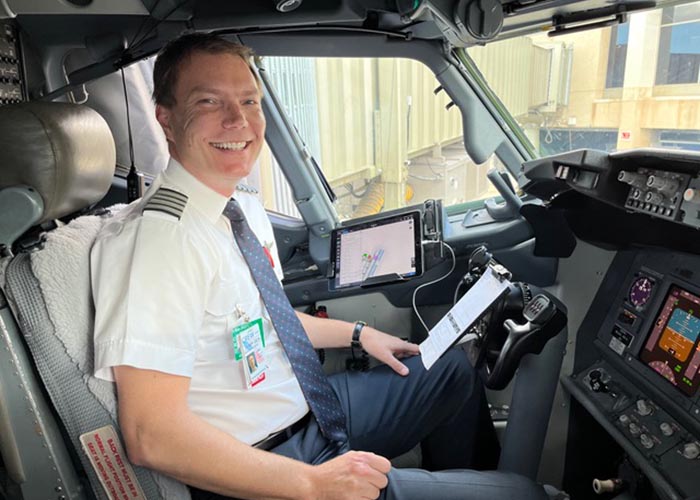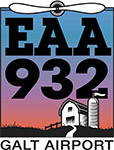by Eric Rehm
Captain Rehm tells a story of a challenging flight made to look easy…
 I was having dinner with my friend Byron not that long ago and he was asking me questions about my job as an airline pilot. Specifically, he asked what us pilots do in the cockpit when we are droning on for hours at a time in cruise flight. I gave him a simple answer of something like, “oh we just shoot the breeze and watch the world go by.” Obviously, that isn’t exactly true. We monitor our flight path and systems for accuracy and communicate with air traffic control but with the help of advanced autopilots, GPS, and flight management systems, our workloads as pilots have been comfortably reduced from even just a decade ago.
I was having dinner with my friend Byron not that long ago and he was asking me questions about my job as an airline pilot. Specifically, he asked what us pilots do in the cockpit when we are droning on for hours at a time in cruise flight. I gave him a simple answer of something like, “oh we just shoot the breeze and watch the world go by.” Obviously, that isn’t exactly true. We monitor our flight path and systems for accuracy and communicate with air traffic control but with the help of advanced autopilots, GPS, and flight management systems, our workloads as pilots have been comfortably reduced from even just a decade ago.
I found myself revisiting this conversation after a particularly challenging flight this past week. I wanted to call Byron and tell him that it’s not as easy as it looks sometimes. There are times when the Captain and First Officer (co-pilot) are working their butts off the entire flight to ensure that our passengers have a smooth flight and can enjoy watching a movie and sipping a cocktail.
On paper, this particular flight was pretty simple. Chicago O’Hare (ORD) to Denver International (DEN) blocked at two hours and ten minutes with a route that measured seven hundred seventy-six miles. Unfortunately, Mother Nature had other ideas and was brewing up a whole bunch of weather issues that we were going to have to deal with.
After a pre-departure reroute that added a couple of hundred miles to our route, a runway change, and some weird taxi instructions from ORD ground control, we managed to takeoff eastbound just before a large thunderstorm descended on ORD. Once the wheels were in the well, I heaved a sigh of relief that we were airborne and on our way. There was not any time to relax however because we were now dealing with circumnavigating the previously mentioned thunderstorm which was continuing to grow in size and intensity. We navigated safely southeast away from the storm but still encountered some moderate turbulence and rain during the climb.
Once clear of the weather in the Chicago area, we turned southwest and headed toward the Kansas City area. We were warily watching a line of thunderstorms develop that ranged from the Dakotas all the way into Texas. With the help of air traffic control, downloadable radar on our iPads, onboard radar and our eyes, we flew from Kansas City southwest towards Wichita, Kansas where there was a gap in the line of storms. It seemed every other airliner in the US was using the same little patch of airspace that we were. The controller working our flight was giving out rapid-fire instructions trying to keep us all out of the weather and from running into each other. Thankfully we managed to get through the line of weather without even a ripple of turbulence.
As we rounded the corner from Wichita heading northwest, we turned our attention to Denver. Frustratingly, the weather was significantly worse than forecast with visibility at three-quarters of a mile, snow and winds gusting up to thirty-nine knots. As we neared Denver, it was becoming obvious that the weather was slowing down arrivals and we were eventually given holding instructions. We were told all arrivals into DEN were stopped and that there would be an update in a half hour. Fuel was now becoming an issue. We did some calculations and decided that we could hold for no longer than a half hour. In an effort to be prepared, we began briefing for a possible diversion to our alternate of Colorado Springs.
As the half-hour mark ticked by and my First Officer’s finger was hovering over the radio transmit button to declare our intentions to divert, air traffic control cleared us out of the hold and back towards DEN. After some delaying vectors, we were eventually cleared for the ILS 35R. I flew the approach all the way down to minimums (200 feet above the ground) and thankfully touched down softly after four hours in the air.
At the hotel that night in Denver I was replaying the flight back in my head. My First Officer and I had been busy from pushback to touchdown. We had been constantly evaluating, making decisions and re-evaluating for four straight hours. Unlike what I told Byron, we had not had the opportunity to shoot the breeze or watch the world go by. We were just too busy. But, other than a late arrival and a few bumps on takeoff, I think the flight was uneventful for our passengers. We made it look easy.

